- Home
- Semester and Timetable Information
- Study Physics
- Our Research
- Our People
- Careers and Alumni
- Seminars, News and Events
- Outreach and School Resources
- About the School
- What is Physics
- The Crawford Observatory
- Frequently Asked Questions
- UCC Futures Quantum & Photonics
- Supports
Dr John Butler
Astronomy in Ireland in the 19th Century Dr John Butler, Armagh Observatory
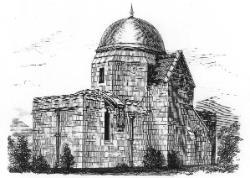
The 19th century has often been referred to as the golden age of astronomy in Ireland. It was a period of great innovation in telescope design and in astronomical discovery, in which Irish scientists played a leading role, and one quite disproportionate to the size of the Irish scientific community. It is perhaps not commonly known that for over seventy years, before the erection of the large telescopes on Mt Wilson and Palomar in California, the largest telescope in the world was to be found at Birr, Co. Offaly. It was with this telescope that the spiral structure of galaxies was first seen; a crucial stage in the realization that they represented huge stellar systems outside our own Galaxy. However, Lord Rosse, the builder of this giant telescope, was not alone, for Ireland had another large telescope builder, the family firm of Grubb in Dublin. This company, originally founded by Thomas Grubb, and later continued by his son Howard, was responsible for many important innovations in telescope and instrument design which subsequently became commonplace and was the only Irish scientific instrument company to achieve international status. The company from its inception in the 1830's, survived until quite recently as Grubb Parsons of Newcastle Upon Tyne, where it built the Anglo-Australian Telescope, erected near Sydney, and the William Herschel Telescope, erected in the Canary Isles. Thomas and Howard Grubb were particularly well known for their large reflecting telescopes, for which they pioneered the use of equatorial mountings with clock drives. Such improved mountings enabled the telescope to be pointed at any object above the horizon and to maintain its position in the field of view for an extended period. Their many innovations, which showed a clear understanding of astronomers requirements, developed from the close contact they maintained with the scientific community. Mostly their telescopes were purchased by existing observatories, however at Cork, Howard Grubb built a complete observatory including the telescope dome, clocks, three major astronomical instruments and their ancillary equipment. This Observatory, though small, is unique in Ireland, if not in Europe, for the remarkable state of preservation of its instruments and the original condition of its buildings.
Howard Grubb was proud of his achievements in Cork and detailed the many improvements he first introduced there in article published by The Royal Dublin Society. Amongst the innovations he mentioned were:
- A telescope mounting that allowed uninterrupted viewing of all objects south of the zenith and above the horizon.
- A new form of telescope drive controlled by electrical impulses from a pendulum clock.
- A telescope on the siderostatic principle which is one of the earliest of its type.
- A duplex micrometer (only one other existed).
- A transit circle that employed circular glass scales, probably the first such use of glass scales in an astronomical or surveying instrument (they are now ubiquitous).
- A novel shutter mechanism for the transit instrument superior to any used previously.
Two of the major instruments incorporated a variety of other labour-saving devices. All in all, the Crawford Observatory is a monument to the ingenuity and craftsmanship of its builders and is of exceptional interest both for the history of the sciences in Ireland and for the technological achievements it incorporates. We would suggest that its conservation should be given a high priority.
The Building
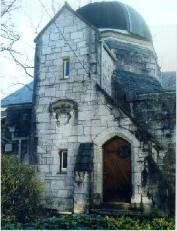
The Crawford Observatory building reflects the ecclesiastical style of the early buildings at UCC and is one of very few in the UK or Ireland that has Gothic architectural features (Morton-Gledhill 1989). The general plan follows the layout developed originally in 18th century Scandinavian observatories, in the Radcliffe Observatory, Oxford and later in many European and American Observatories, with a two storey central section flanked by single storey wings, one to the east and one to the west of the central block. The purpose of this layout was
(i) to provide stable foundations (close to the ground) for position measuring instruments, such as the Transit Circle, and
(ii) to place the equatorial telescope, which needed to view the whole sky, high in the building so that it had an uninterrupted view of the sky down to the horizon.
At Cork the second wing (the west) was used to house the siderostatic telescope which was primarily intended for observation of the Sun.
The Equatorial Telescope
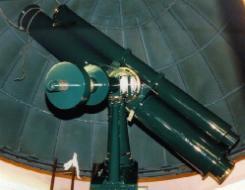
In its modified form, the equatorial telescope was intended to provide photographs of sections of the northern sky for the `Carte du Ciel' project. This huge undertaking, which was initiated by international agreement in Paris in 1887, involved a number of observatories around the world in producing a photographic map of the heavens showing stars down to the 14th magnitude. A number of trial plates survive at UCC. Howard Grubb produced seven of the thirteen astrographs built for the 'Carte du Ciel' project; others went to Greenwich, Oxford, Melbourne, Mexico, Perth and Cape Town.
The Transit Circle
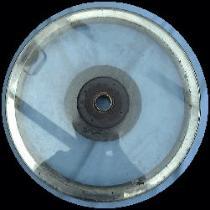
The Transit Circle is situated in the single storey east wing. It is a superb example of Grubb's workmanship and is undoubtedly the most complete and best preserved instrument of its type in Ireland today. Transit instruments were employed to measure accurate positions of stars; the basic raison d'etre of a 19th century observatory. More precise stellar positions were required for: studies of the dynamics of the solar system and tests of the validity of Newton's Theory of Gravitation, and for the improvement of navigation at sea. Several such instruments operated in Ireland in the 19th century, including a Pistor and Martin Circle at Dunsink, a Jones Transit Instrument and Mural Circle at Armagh, and a Transit Instrument by Troughton and Meridian Circle by Ertel at Markree. However, the Cork instrument is the only one to survive intact to the present day, in its original condition and setting. The Transit Circle was designed with a view to mechanical stability - an important requirement for such accurate work. This, together with the difficulty astronomers had with reading metal scales by reflected light, lead Grubb to implement its most original feature, namely the use of declination scales inscribed on glass and read with transmitted light. This was a new development by Grubb which has subsequently found favour by many astronomical and surveying instrument manufacturers.
The apparatus for reversing the instrument appears to be complete and convenient to use. Similarly the shutter design is novel and an advance on earlier arrangements. Outside the building, to the north and south, are cradles for a collimator which was required to allow the instrument to view distant meridian marks which provided reference points to check the stability of the instrument. The northern mark would be expected to be positioned on the south facing wall of the College Quadrangle. A d.c. lighting system, operated with power from the tramways, was installed to illuminate the circles (and presumably the cross-wires). It is unlikely that the instrument saw much active service and this fact is responsible for its present excellent condition.
The Siderostatic Telescope
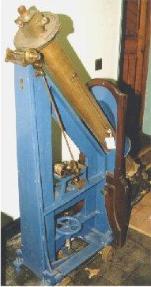
A telescope which followed stars automatically to counteract the Earth's rotation and gave an image in a stationary eyepiece teased the imagination of a number of telescope builders of the 19th century. The concept, which originated in France in the 1830's, intrigued Howard Grubb who designed several telescopes on this principle. The Cork instrument is the earliest one he actually built. Later he constructed a siderostat for Kodaikanal in India (C 1900) and further developed the principle with a type of Coude siderostatic telescope for Cambridge University (The Sheepshank Telescope). His basic design of a rotating polar telescope, with a flat mirror at the bottom to reflect the sunlight, is an extremely simple and elegant solution to the problem. In the final decade of the 19th century, the principle of the siderostatic telescope developed into the `coelostat' which has subsequently been employed largely for solar observations. The Cork siderostatic Telescope, though small, is an important link in the development of this type of instrument which, though it did not gain popularity for stellar work, reached its ultimate fruition in the giant polar solar telescopes such as that at Kitt Peak, Arizona. The Cork Siderostatic Telescope is mounted on a trolly which moved on rails into a convenient position at a window in the south wall of the west wing of the building where it could view the sky south of the zenith. The window has subsequently been covered over, but the rails may still survive under the floor panels. The instrument itself, apart from a little corrosion, is in near perfect condition and has probably seen very little active use.
References
Burnett, J.E. 1989, Vulgar and Mechanick, Royal Dublin Society.
Glass, I.S. 1997, Victorian Telescope Makers - The Lives and Letters of Thomas and Howard Grubb, Inst. of Physics Publ.
Grubb, H. 1880, Scientific Proceedings of the Royal Dublin Society - Vol II,
part V
Mollan, C. 1989, Irish National Inventory of Historic Scientific Instruments - Interim Report, Royal Dublin Society.
Morton-Gledhill, R.I., 1988, Vistas in Astronomy John Butler,Armagh Observatory 27 Jan. 1994
